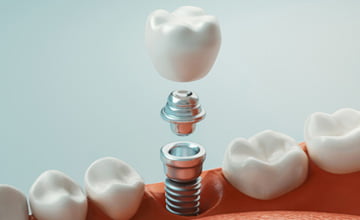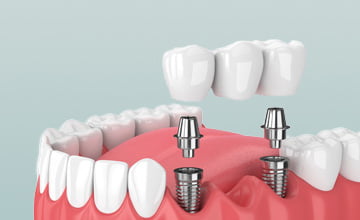Crown and Bridge
Pickering Smile Centre – Restoring Smiles with Dental Crowns & Bridges
Our teeth naturally wear as we age. No one wants to lose their teeth and no one would willingly choose to allow tooth loss to occur. Conditions such as cavities, broken or missing teeth, deep staining, and even large old metal fillings can impact the health of your teeth. These issues can affect both the appearance of your smile and have a negative impact on your oral health.
For those looking for affordable, simple solutions for tooth repair or replacement that do not involve surgery, dental crowns and bridges can offer a less costly alternative to dental implant procedures. This type of treatment requires limited chair time in the dental office, and offer a great option for individuals who are looking for a simple way to restore or replace their damaged or missing teeth.

What Is a Dental Crown?

A dental crown (also sometimes referred to as a cap) is a custom fitted, strong restoration that covers the whole part of your tooth that is above the gumline. A crown can be used to restore shape and size, as well as to add strength to compromised tooth structure. A crown can be used to repair a tooth, and also to protect your tooth from further damage such as cracking or chipping.
Why did my dentist recommend a crown?
Sometimes when a tooth is severely damaged or weakened by root canal procedures or fractures, a simple filling is no longer an option for restoration.A crown is a strong restoration that is used to repair badly damaged teeth or to prevent further damage to weakened tooth structure.
What is the Procedure
for a Dental Crown?
The fabrication and placement of a dental crown is a simple procedure that may involve one or two office visits. The first step is to prepare the tooth. Decay is removed and the remaining tooth structure is prepared to accommodate the crown. This involves removing a thin layer of enamel using local anaesthetic (dental freezing) Next, an impression is taken of the tooth to be crowned. Digital scans are used to record the anatomy of the tooth both before and after the preparation. With modern technology, we no longer have to use messy gooey impression material to do this! The information from the scans is then sent to our lab, where your crown is custom made to our exact specifications. The last step in the first appointment is to place a temporary crown on the tooth while we are awaiting your custom made crown. The last step, done at a second appointment is the insertion and cementation of the crown. This is usually a very short visit and often requires no freezing or anaesthesia.
Sometimes, in certain cases, a crown can be prepped, created and cemented all in one day with only one office visit. This is done using special in-office 3d printing or milling technology, with the aid of a digital scanner. This type of same-day crown procedure eliminates the need for a temporary crown, and multiple appointments to treat the same tooth.
How Long Should My Crown Last?
With good oral hygiene home-care and routine check-ups with your dentist, crowns can last for many years, and sometimes a lifetime. The materials used now far exceed the durability and longevity of older restorative materials.
What Is a Dental Bridge?

When a single tooth or multiple teeth in one area need to be replaced, a dental bridge may be a good solution. A dental bridge is called a bridge because it uses adjacent teeth as anchors to support a custom-made porcelain bridge, to replace single or multiple teeth all in one restoration.
Why did my dentist recommend a bridge?
A bridge replaces single or multiple adjacent missing teeth without any of the surgery associated with placing dental implants. Bridges can provide a stable, long-lasting alternative to removable partial dentures.
By filling spaces left by missing teeth, a bridge can prevent neighboring teeth from shifting out of place. A bridge is often a good way to get a great aesthetic result and restore function without considering more invasive surgical procedures.
What is the Procedure
for a Dental Bridge?
Similar to a crown, a dental bridge procedure is generally completed in two visits. The first appointment is to prepare the anchor teeth for the bridge and to use a 3D scanner to take digital impressions before and after the preparation. These days, an intraoral scanner takes the place of traditional gooey impression material. This is a big relief to patients who suffer from an extreme gag reflex or taste and texture sensitivities. Once the scans are complete, a temporary bridge is placed and the digital impressions are sent to the lab. There, your bridge is custom created just for you to match your existing teeth and to fit perfectly, filling the space left by your missing teeth. A couple of weeks later, you will return to the office to have the temporary bridge removed and the new, permanent bridge cemented into place.
Sometimes, in certain cases, teeth can be prepped, a bridge can be created and cemented in place all in one day, with only one office visit. This is done using special in-office 3d printing or milling technology, with the aid of a digital scanner. This type of same-day dental bridge procedure eliminates the need for a temporary bridge, and does not require multiple appointments to complete the treatment.
How Long Should My New Bridge Last?
By maintaining good oral hygiene and regular dental check-ups, a dental bridge can have a long lifespan. You can expect to enjoy your smile for years to come.

Get Started Today!
Discuss your options from the comfort of your home with a FREE virtual consultation, or book an in-person appointment at Pickering Smile Centre to see if dental crowns and bridges are a good option for you to repair or replace missing and damaged teeth.
Smile Gallery

